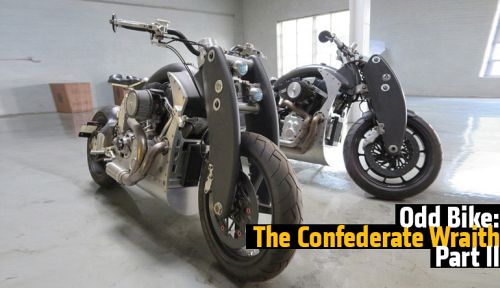It is late 2005 and Confederate Motors is in shambles. Fresh from the epic high of securing a high-profile investor in the Middle East, the company’s president Matt Chambers and lead designer JT Nesbitt returned to their New Orleans base of operations to discover that their factory has been destroyed by the winds and flooding brought on by Hurricane Katrina. With their facilities in ruins and their insurance company bankrupted by the claims in the aftermath of the storm, it looks like the infamous purveyor of brutal, radical and rebellious motorcycles is no more. Katrina has seemingly crushed the hopes of bringing Nesbitt’s iconoclastic Wraith design to production.
The situation appeared dire and the circumstances were debilitating, particularly for a tiny boutique manufacturer that had constantly fought with debt, flirted with bankruptcy, and struggled to meet the demand for their two-wheeled anti-establishment icons. A few frames and components were salvaged from the ruined factory, as were most of the computer files and company books, but the operation was a long way away from building bikes - particularly when New Orleans was still wracked with instability, crime and resource shortages in the wake of flooding. In spite of the literal collapse of their New Orleans factory, Confederate’s anonymous investor/saviour had maintained his end of the agreement and would provide the capital needed to renew the company. The question remained: with the factory gone and New Orleans in shambles, where would Confederate build its bikes?
The unstable period following Katrina led to a great deal of internal turmoil and emotional conflicts within the company. Former employees of Confederate often liken their time at the company as being part of a “family”, a tight-knit and sometimes conflicted group of misfits who loved each other as much as they believed in the machines they were helping create. Many suffered long hours and paltry (or nonexistent) wages to help support the company in times of financial trouble, their contributions a true labour of love that spoke to the passion they felt for what they were building and the charismatic nature of the philosophy that Chambers espoused.
It was not a surprise, then, that following the horror of Katrina and the destruction of the factory many intense emotions would come to fore. The period following the hurricane is rife with conflicting stories, disagreements, and defensive statements that need not be repeated here. All that is important for the telling of this story was that the ultimate outcome was that Chambers made a decision to leave New Orleans and start the company anew in a more favourable location, and JT Nesbitt made the decision to leave the company and remain in Louisiana.
Brian Case continued to work as a consultant for Confederate through his Pittsburgh-based company, Foraxis. In addition to helping Nesbitt design and build the Wraith XP1 and B91 prototypes, Case had a team of CAD modellers working on digitizing the components and blueprints for the G2 Hellcat into ThinkId files to streamline production. Following Katrina it seemed that Foraxis would lose its biggest and highest profile client, but Chambers saw a place for Case in the post-Katrina re-organization of the company and began discussing the possibility of bringing him on board. It would prove to be a difficult but momentous moment in Cases’ career – here was the possibility of leaving his stable business to join one of the most innovative and adventurous motorcycle companies in the world. Case felt that there was nothing else that could be as fulfilling as working for Confederate. It seemed like a dream opportunity, and in spite of the destruction wrought by Katrina there appeared to be promising opportunities on the horizon.
After canvassing locations across the United States an offer was extended for Chambers to visit Birmingham, Alabama in December 2005. The offer was made by local magnate and motorcycling icon George Barber. A wealthy industrialist who had made his fortune in the dairy industry and local real estate, Barber was renowned for building the finest collection of motorcycles in the world: the world-class Barber Vintage Motorsports Museum is home to largest and most thorough catalogue of rare, significant, and historically important production and racing motorcycles anywhere in the world.
George Barber is an imposing but well respected figure in the Birmingham area, a powerhouse business maven who balances his acumen with a friendly, cordial attitude that has earned him a great deal of respect in the local community. So when George Barber makes you an offer, you pay attention. Chambers was invited to the Barber Motorsports Park to discuss the possibility of moving to Birmingham, and made a point to bring Case along. Barber made a strong case for the move with some significant incentives, including a year's free rent in an 8,500 square foot downtown warehouse on Fifth Avenue South to get the operation back on its feet. An agreement was made and after several months of insecurity Confederate was set to move to Birmingham...













24
Comment